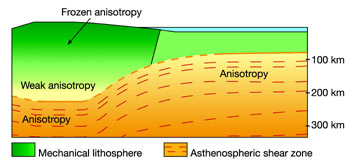Continental roots go deep, but not as deep as some people thought
BERKELEY – The roots of the continents go down between 200 and 250 kilometers (125-160 miles), forming a distinct boundary with the underlying mantle like that seen under the oceans, according to a team of seismologists at the University of California, Berkeley.
Their interpretation of seismic data resolves a debate within the geophysical community about the depth of the boundary between the rigid lithosphere that floats on the Earth's surface and the hot convecting mantle that underlies it.
"It was very clear that you had a lithosphere about 80 kilometers thick, on average, in the ocean basins, and under that is the asthenosphere - the very top of the mantle," said Barbara Romanowicz, professor of earth and planetary science at UC Berkeley and director of the Berkeley Seismological Laboratory. "But under the continents, it wasn't as clear. What we are now saying is that we are seeing the same thing under the continents - it's a little more subtle signal, but it's there."
 A cross-section of the Earth's surface shows that the lithosphere (green) is thicker under the continents than under the oceans. The asthenosphere, the very top of the mantle, can be detected because of its anisotropy - horizontally polarized shear waves generated by earthquakes travel faster through this rock than vertically polarized seismic waves. (Credit: UC Berkeley Seismological Laboratory) |
The ocean lithosphere is thin when spewed out at the mid-ocean ridges, thickening to as much as 80 kilometers (50 miles) as it is pushed outward to make room for more ocean bottom. Continents, however, are much older and much thicker, and vary a lot more around the globe.
Romanowicz and UC Berkeley graduate students Yuancheng Gung and Mark Panning claim in a paper in the April 17 issue of Nature that some estimates of the thickness of the continental lithosphere are based on a misinterpretation of the earthquake-generated seismic waves recorded after they pass through the base of the lithosphere and the top of the mantle. These waves are used by geophysicists to image the Earth's interior, like X-rays in computed tomography (CT) scans.
The continental lithosphere is composed of a thin, 30-50 kilometer-thick layer of crust atop a hot layer of rock. Seismic waves tend to travel faster through the lithosphere, then slow down when they pass through the asthenosphere.
The UC Berkeley team argues that only the vertically polarized seismic shear waves slow down in the asthenosphere, while the horizontally polarized waves continue to travel faster down to a depth of about 400 kilometers. This has confused geophysicists looking only at horizontally polarized shear waves, leading them to conclude that the lithosphere descends down to 400 kilometers.
By taking into account the different shear wave velocities, the boundary between the lithosphere and asthenosphere works out to be between 200 and 250 kilometers, in agreement with other methods.
"Overall, (the UC Berkeley seismologists) have provided a satisfying way forward in tackling a long-standing puzzle in earth science," said Brian L. N. Kennett of Australian National University in a Nature commentary.
"One consequence of this is that the asthenosphere is a prevailing global feature," Romanowicz added. "I think there is something very special about the asthenosphere of the Earth that is very important in the character of the plate motion."
What distinguishes Earth from the solar system's other planets, which don't have plate tectonics, that is, moving surface plates, is that the Earth has a very well developed asthenosphere which helps move the plates around, she said.
"Somehow the asthenosphere needs to be sustained over geological times, and I think that heat is being pumped from below and is actively keeping the asthenosphere less viscous and more deformable," she said, and thus able to move the lithosphere around.
In a Science paper a year ago, Romanowicz and Gung proposed that this heat pump consists of massive plumes of hot rock, or superplumes," rising through the mantle.
The UC Berkeley work was funded by the National Science Foundation.

